The Samsung Galaxy S20 Ultra 5G is the company’s latest high-end smartphone and features the recent Exynos 990 chipset, a 6.9-inch AMOLED display, a high-capacity 5000mAh battery, and an advanced quad-camera setup on the rear.
For selfie shooters, Samsung’s latest model isn’t short on innovation on the front camera either, thanks to a neat trick that simulates a dual-camera setup. Although it features just a single sensor, the S20 Ultra can shoot selfies in both full frame or cropped format, with the latter simulating a longer focal length. Its 40MP 1/2.65-inch Quad-Bayer sensor with 2×2 pixel binning outputs 10MP images with a 25mm-equivalent focal length in its wide-angle mode, which it automatically selects when it detects two or more faces. By default, however, the S20 Ultra shoots in its cropped mode, with the same sensor producing a lower-resolution 6.5MP output at a longer 32mm-equivalent focal length when capturing single-person selfies.
The lens features PDAF autofocus, but no optical image stabilization (OIS). There’s auto-HDR processing, a screen-flash solution for low-light selfies, and an AI (artificial intelligence) mode that is enabled by default to optimize camera settings and processing based on the scene.
For front camera video, the S20 Ultra shoots at Full HD 1080p at 30fps by default, with high-resolution 4K capture at either 30fps or 60fps available as well. With no OIS on the lens, video stabilization is electronic (EIS); and the EIS crop uses the full sensor for a 25mm-equivalent field of view when shooting video.
The S20 Ultra 5G posted a solid set of scores in our main camera review. Let’s find out how its front camera fared in our DXOMARK Selfie tests.
Key front camera specifications:
- 40MP 1/2.65-inch Quad-Bayer sensor with 0.7µm pixels
- 25mm-equivalent f/2.2-aperture lens (no OIS)
- Default cropped 6.5MP output at 32mm-equivalent focal length
- Optional uncropped 10MP wide-angle output at 25mm-equivalent focal length
- Automatic wide-angle switching for dual or group selfies
- AI enabled by default
- PDAF autofocus
- 4K/60fps (1080p/30fps at default settings)
About DXOMARK Selfie tests: For scoring and analysis in our smartphone front camera reviews, DXOMARK engineers capture and evaluate over 1500 test images and more than 2 hours of video both in controlled lab environments and in natural indoor and outdoor scenes, using the camera’s default settings. This article is designed to highlight the most important results of our testing. For more information about the DXOMARK Selfie test protocol, click here.
Test summary


With an overall score of 100 points, the Samsung S20 Ultra moves into joint second spot in the DXOMARK Selfie database alongside Huawei’s nova 6 5G, and is just three points behind the top-ranked Huawei P40 Pro at 103. Samsung’s latest front camera puts in a very consistent performance, achieving a top-five result in each tested category across our Photo and Video analysis.
Its new larger Quad-Bayer sensor represents a big hardware upgrade over Samsung’s previous Note 10+ 5G device, but we don’t see a significant improvement in image quality overall; and at 99 points, the Note 10+ 5G is only one point behind the S20 Ultra. So while it’s fair to say the S20 Ultra’s updated hardware doesn’t deliver a revolution in front camera image quality, its stable performance makes it a reliable option for selfie enthusiasts interested in shooting stills and videos under various lighting conditions.
An excellent Photo score of 104 is again bettered only by Huawei’s P40 Pro and nova 6 5G, at 108 and 105 points, respectively. The S20 Ultra’s exposure, autofocus, noise, bokeh, and detail are key strengths for stills, with results for exposure particularly strong. Exposure is accurate on faces even in low-light situations, and generally wide dynamic range in bright outdoor conditions ensures well-exposed backgrounds and skies for striking results. The PDAF autofocus is accurate and reliable, providing in-focus faces at a range of distances; and bokeh shots display good subject segmentation despite the lack of a dedicated depth sensor. In both outdoor and indoor selfies, the level of detail on the S20 Ultra is high and noise is controlled well.
Color is the device’s main area for improvement, with minor white balance casts visible in almost all images; further, skin tone rendering can be slightly unpleasant in certain conditions. It’s far from the worst we’ve seen, but it is the one area in which the S20 Ultra’s selfies fall short compared to the top-performing Huawei devices. Flash shots could be improved, too, as the screen-flash solution often produces white balance color casts as well as visible noise on faces.
With a Video score of 95, the Samsung Galaxy S20 Ultra becomes our joint top-ranked device for front camera video alongside the Huawei P40 Pro. Users will have few complaints when recording vlogs or other selfie videos, thanks to excellent exposures even in low light, well-defined detail, pleasant color, and a wide depth of field that ensures multiple subjects and backgrounds are reasonably sharp. Autofocus instabilities with minor but unnecessary refocusing are a slight concern, and some exposure variations are occasionally visible when the camera is moving while recording. White balance is also a little cold outdoors, and noise and artifacts are visible in certain lighting conditions; but broadly speaking, all these problems are minor, and the S20 Ultra can be relied upon for generally excellent front camera video quality.
Photo scores explained
With 104 points, the Samsung Galaxy S20 Ultra currently achieves the third-highest Photo score in our database, behind Huawei’s P40 Pro and nova 6 5G smartphones. We calculate the Photo score from results and analyses of tests that examine different aspects of a device’s still-image performance under different lighting conditions. In this section, we’ll take a closer look at these image quality sub-scores, analyzing some aspects of the S20 Ultra’s performance versus key competitors.

Exposure and Contrast
Samsung Galaxy S20 Ultra 5G (Exynos)
87
91
The S20 Ultra turns in a new top score for selfie exposure, thanks to accurate exposure on faces in all well-balanced lighting conditions, including very low light, and wide dynamic range in high-contrast test scenes. The S20 Ultra scored well both in our lab measurements of its handling of high levels of contrast in all simulated conditions, and in our perceptual analysis of its exposure performance of natural test scene images.
In high-contrast outdoor scenes, the S20 Ultra’s exposure on faces is generally good, and it controls highlights well both in bright skies and on faces, with minimal clipping evident. In this example below, all three devices offer wide dynamic range with good contrast, and although the Note 10+ 5G delivers a slightly brighter exposure overall, the S20 Ultra image is a slight improvement over the darker nova 6 5G image.
In challenging high-contrast indoor scenes, exposure on faces is sometimes low in the S20 Ultra’s backlit shots. Target exposure is better in the side-lit example below, but some clipping is evident on faces in both the S20 Ultra and P40 Pro images. The iPhone 11 Pro Max controls the highlights on the face much better, although contrast and color are a little flat in the Apple image.

Color
Samsung Galaxy S20 Ultra 5G (Exynos)
87
105
Color is the main area for improvement on the S20 Ultra, with slight white balance casts visible in almost all lighting conditions, and occasionally inaccurate skin tone rendering. Color is generally best in outdoor shots, and as you can see in the example below, color rendering can often be pleasant, with accurate white balance and nice skin tones. We found the S20 Ultra’s color rendering a little inconsistent in general, however, with skin tones varying from quite pinkish to pale, and undersaturated in many examples.
Color shading is barely noticeable and white balance is generally accurate indoors and in low light. In this indoor test scene, however, you can see that the pinkish skin tones look a little unnatural.

Focus
Samsung Galaxy S20 Ultra 5G (Exynos)
83
97
Focus is a nice strength for the S20 Ultra, with its PDAF autofocus lens ensuring sharp and in-focus faces at all tested distances. Although all key competitors have good focus at all tested distances in our lab analysis, levels of acutance are higher on the S20 Ultra and the P40 Pro compared to the Phone 11 Pro Max.
Accurate focus ensures that the level of detail on faces is generally high at close, medium, and long ranges in both outdoor and indoor images. The S20 Ultra isn’t quite a top performer, however, with slightly limited depth of field in some lighting conditions. Its large 1/2.65-inch sensor makes good depth of field quite challenging, and although it’s acceptable in many two-person or group selfies in outdoor and indoor conditions, it’s not as good in low light nor when compared to some of the best devices for this attribute (such as the iPhone 11 Pro Max).

Texture
Samsung Galaxy S20 Ultra 5G (Exynos)
69
85

Noise
Samsung Galaxy S20 Ultra 5G (Exynos)
78
90
A solid if not outstanding result for photo texture, with high levels of detail in outdoor and indoor conditions, where the S20 Ultra achieved around 70% acutance in our lab analysis. This means that facial details are very well defined in natural test scenes, but detail wasn’t quite as high or consistent as the P40 Pro in our measurements. Detail on the S20 Ultra drops off quickly in low light due to fairly long exposure times, with acutance down to around 20% on handheld shots at 1 lux; and even when using a tripod in these conditions, the S20 Ultra’s detail was a long ways off from that of the P40 Pro.
But if you seek out some half-decent lighting for shooting selfies, you won’t have too many complaints about detail on the S20 Ultra. In fact, in many of our outdoor and well-lit indoor test scene images, facial details from the S20 Ultra were slightly better defined compared to the P40 Pro and the Note 10+ 5G, both of which output a higher-resolution file than the S20 Ultra in its default “cropped” mode.
The S20 Ultra also controls noise well, but again, it was some ways off from our top performer, the P40 Pro, in low-light conditions in the lab. In the analysis below, all three devices handle visual noise well under simulated indoor (100 lux) and outdoor (1000 lux) lighting conditions, but the P40 Pro is significantly better in low light.
So while the S20 Ultra isn’t a top performer for texture or noise, it generally handles the tradeoff very well in most images. In the background of this indoor test scene, the P40 Pro offers the smoothest results, but the S20 Ultra displays less visual noise compared to the iPhone 11 Pro Max.

Artifacts
Samsung Galaxy S20 Ultra 5G (Exynos)
83
92
Image artifacts are very well controlled on the S20 Ultra and don’t negatively impact overall image quality too much. The main penalties we applied were for distortion and color quantization, with smaller point losses for anamorphosis (perspective distortion) of elements towards the edges of the frame, color fringing, and face rendering artifacts.

Flash
Samsung Galaxy S20 Ultra 5G (Exynos)
88
93
Flash is another another area for slight improvement on the S20 Ultra, with white balance color casts and visible noise in faces the main reasons for it falling slightly behind the best performers. Using the S20 Ultra’s screen-flash solution in total darkness (0 lux), the overall exposure is fairly good, and although there’s some slight corner shading, it’s reasonably well controlled. The texture-versus-noise tradeoff here isn’t as good as on the nova 6 5G, however, and the S20 Ultra displays some visible noise, low facial detail, and color quantization artifacts; moreover, the white balance is a little cold.

Bokeh
Samsung Galaxy S20 Ultra 5G (Exynos)
70
75
A surprisingly good result for the S20 Ultra’s bokeh shots, considering that the single-camera device doesn’t feature a dedicated depth sensor. In the best examples, subject segmentation is good, with only minor edge artifacts visible around the subject, and the shape of the bokeh is pleasant, with well-contrasted spotlights. The effect is also repeatable over consecutive shots for consistent results, and the level of noise is uniform across both blurred and sharp areas.
It’s still not quite as good as the best dual-camera devices we’ve tested, but the S20 Ultra shows a nice improvement over the Note 10+ 5G. Despite its lack of stereo vision, Samsung’s bokeh algorithms are now able to identify objects on the same plane as the subject and keep them sharp, which produces a much more natural effect compared to the Note 10+ 5G, which just blurred everything other than the subject. That said, rather abrupt blur transitions do still occur, which can look unnatural, but the S20 Ultra’s images in Portrait mode are pleasing overall.
Video scores explained
Tested in 2160p/30fps mode, the Samsung Galaxy S20 Ultra is an excellent performer for front camera video, and with 95 points, sits at the top of our selfie video rankings alongside the Huawei P40 Pro. Very consistent video performance with only a couple of notable weaknesses makes it a reliable option. A very good texture-versus-noise tradeoff ensures that detail is a nice strength, and videos display very few obvious artifacts. The S20 Ultra’s Video sub-scores are as follows: Exposure (74), Color (83), Focus (79), Texture (89), Noise (79), Artifacts (84), and Stabilization (75).
Tested in the lab, the S20 Ultra delivers bright exposures with high levels of contrast in all lighting conditions, including low light (5 lux). Dynamic range is also very wide in front camera videos shot in high-contrast conditions, where the S20 Ultra delivers better detail in the shadows with less highlight clipping compared to the iPhone 11 Pro Max.
Detail preservation is the S20 Ultra’s main strength for selfie videos, with exceptionally good levels of acutance in all lighting conditions. It’s very consistent, too, with over 80% acutance measured in our lab tests between simulated low light (20 lux) and bright light (1000 lux) conditions. At 20 lux, it’s notably better than both the P40 Pro and the iPhone 11 Pro Max; and although detail tails off in very low light as you’d expect, even in near-dark conditions of just 1 lux, the S20 Ultra is able to maintain reasonable levels of detail of around 35% acutance.
Noise is slightly visible in all lighting conditions, and some temporal and spatial noise effects were evident in both our lab analysis and in videos shot across a range of different environments. That said, broadly speaking, it’s better than both the P40 Pro and the iPhone 11 Pro Max for video noise; and considering its exceptional detail preservation, the S20 Ultra has found a nice balance between texture and noise.
Color rendering is generally pleasant, and although outdoor videos tend to display a slightly bluish cold white balance color cast, it’s far from offensive. The device’s main weaknesses for video concern autofocus, texture rendering artifacts, and stabilization. Slight autofocus failures are common, especially when recording while walking and in panning videos where the scenery is changing. The device doesn’t completely lose focus, but fairly regular and unnecessary refocusing occurs.
In the sample clips below we can see some exposure stepping on the Samsung as the camera is adapting to the changing scenery. There is also some highlight clipping visible in the sky but the S20 Ultra is better at rendering highlight detail than the comparison device, the Huawei nova 6 5G.
On the whole, the S20 Ultra’s front camera EIS video stabilization is also pretty good, and backgrounds are particularly stable in selfie videos shot while walking. The stabilization system has to choose between correcting the face or the background, however, and some residual motion on the subject is often present as the subject moves. There’s also a slightly odd texture rendering artifact, where texture behind the subject appears to be moving independently; combined with the stabilization issue, this can produce slightly weird results. These problems are fairly minor on the whole, but they do slightly temper an otherwise excellent video performance.
Conclusion
With no significant flaws and consistently good performance across front camera photos and videos, the S20 Ultra is good choice for selfie enthusiasts and deserves its joint second-place ranking in our DXOMARK Selfie database.
Although a big hardware upgrade to a 40MP Quad-Bayer sensor doesn’t ultimately lead to a vast improvement in image quality over the Note 10+ 5G, the S20 Ultra shows some interesting innovation via its single camera with dual focal length capabilities. Automatic switching means you get a better field of view for single or group selfies without any photographer intervention, and of course more advanced users can manually switch between the two if required. The S20 Ultra’s cropped 32mm-equivalent shots do output a lower-resolution 6.5Mp image, but even so, still image detail remains very good.
Generally good exposure, wide dynamic range, pleasant bokeh shots, low noise, and reliable autofocus delivering sharp faces with the camera at different distances from the subject all help ensure excellent images. Add to that class-leading front camera video, and photographers will be more than happy with the results from the Samsung Galaxy S20 Ultra’s selfie camera.
Photo
Pros
- Accurate exposure on faces and wide dynamic range
- Accurate and reliable autofocus
- Well-controlled noise outdoors and indoors
- Accurate depth estimation in bokeh shots
- High levels of detail outdoors and indoors
Cons
- White balance casts in almost all lighting conditions
- White balance casts and visible noise using flash
- Slightly inaccurate color and skin tone rendering
- Anamorphosis visible in group pictures
Video
Pros
- Accurate exposure down to low light
- High detail in all videos
- Vivid and pleasant color outdoors and indoors
- Wide depth of field


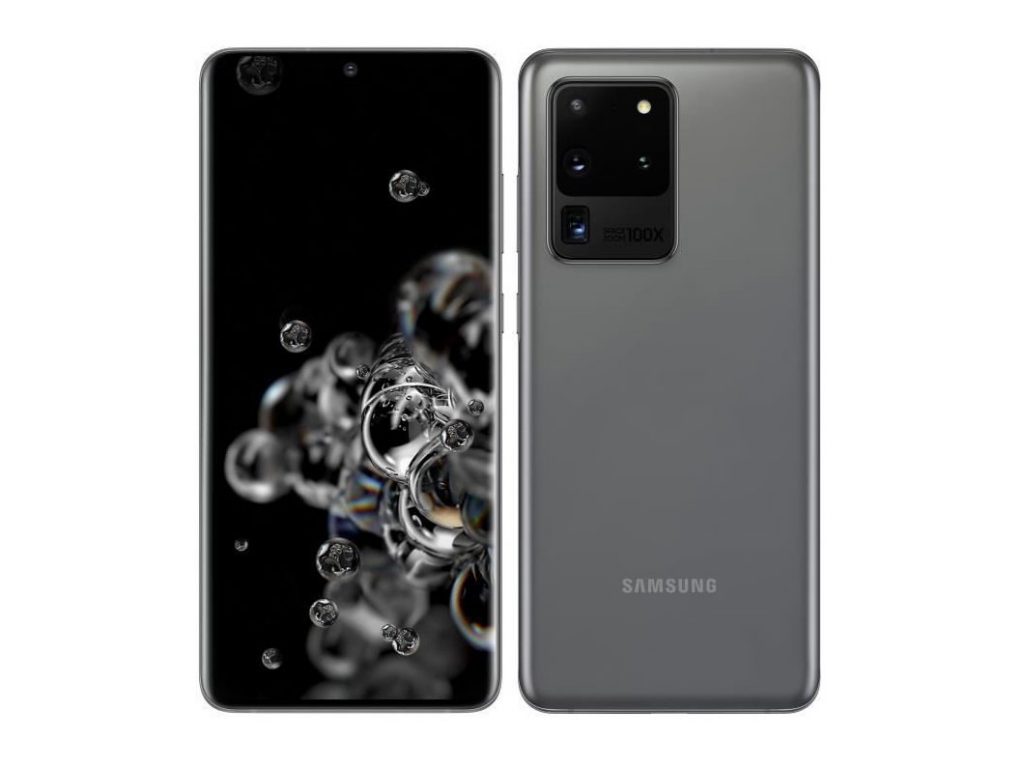
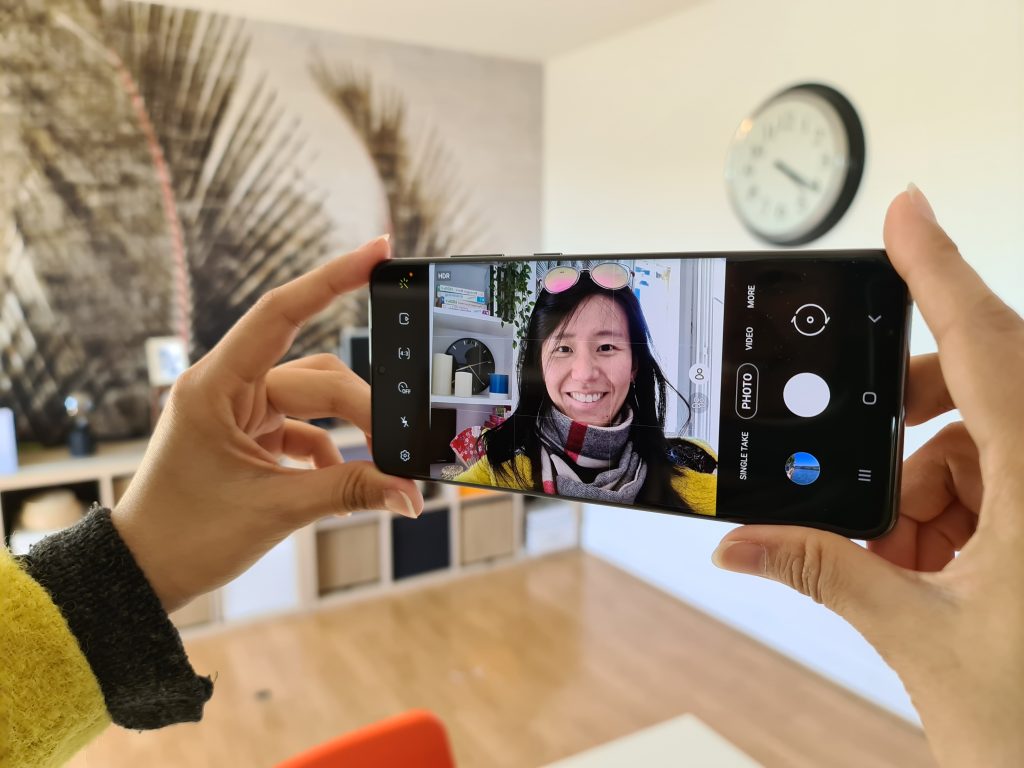
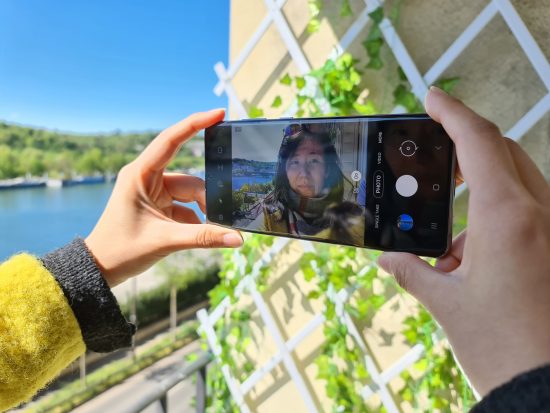
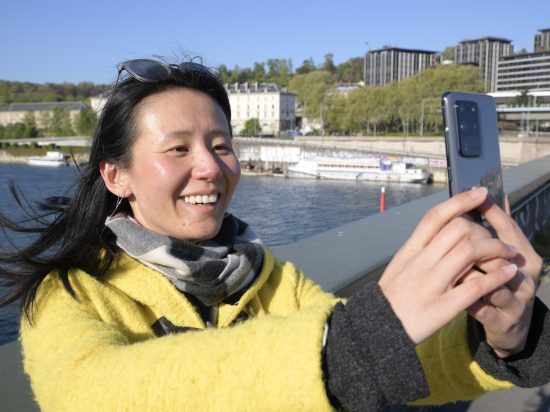













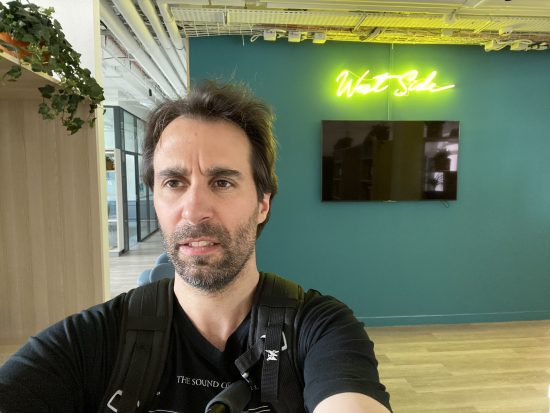
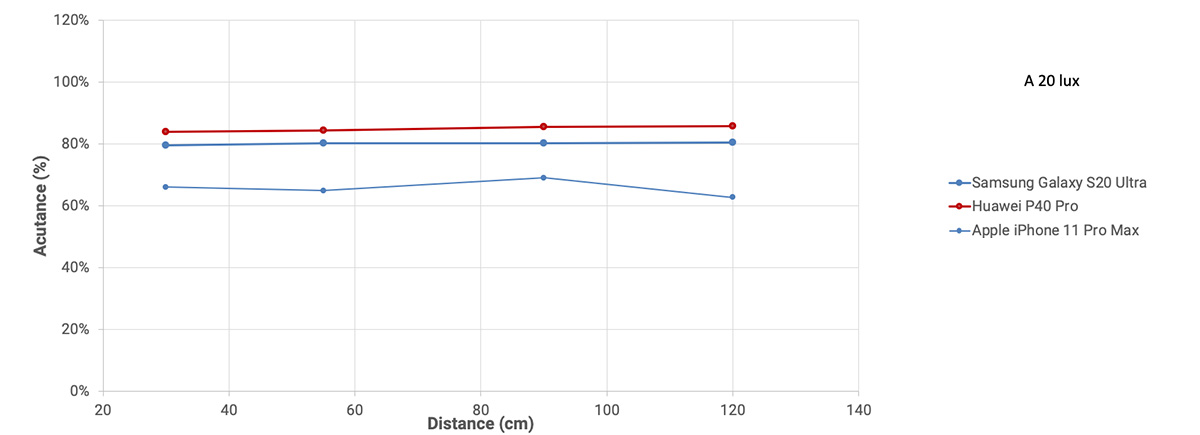



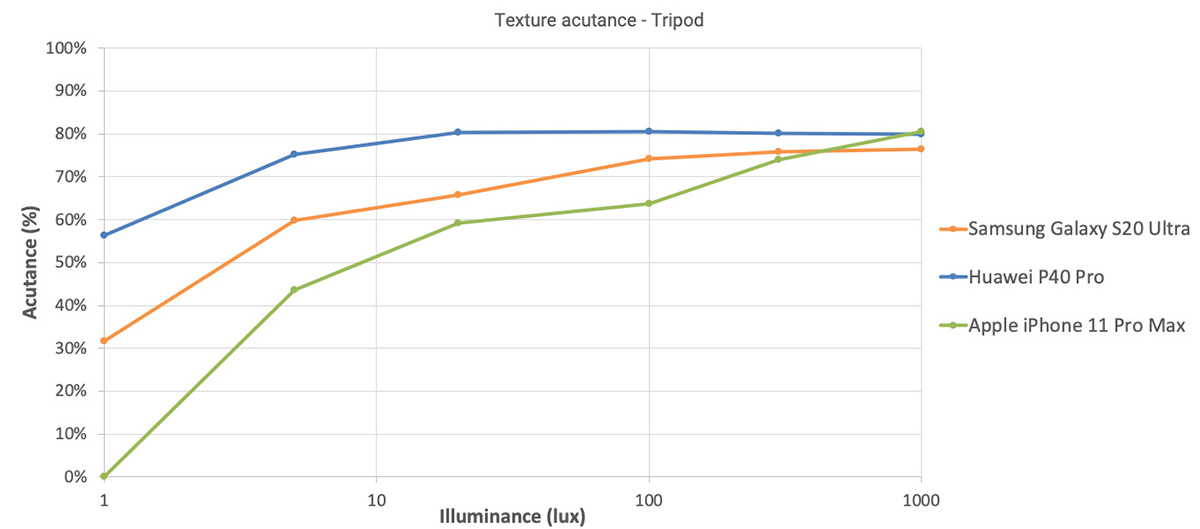
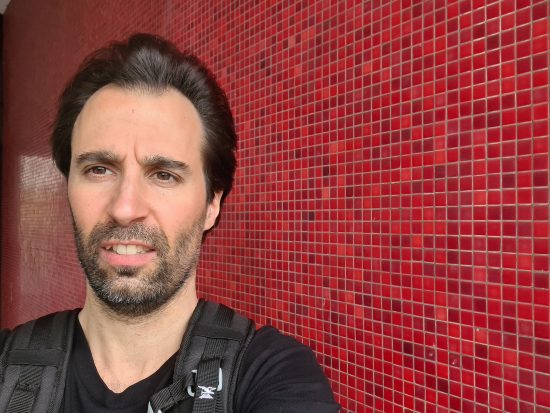
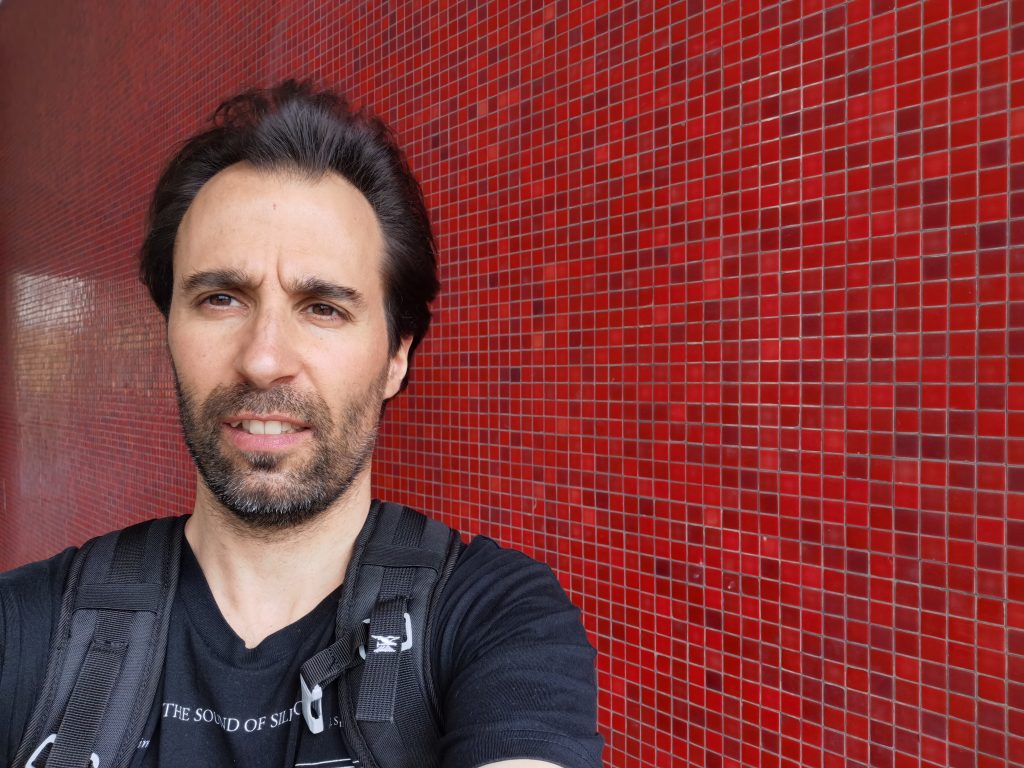
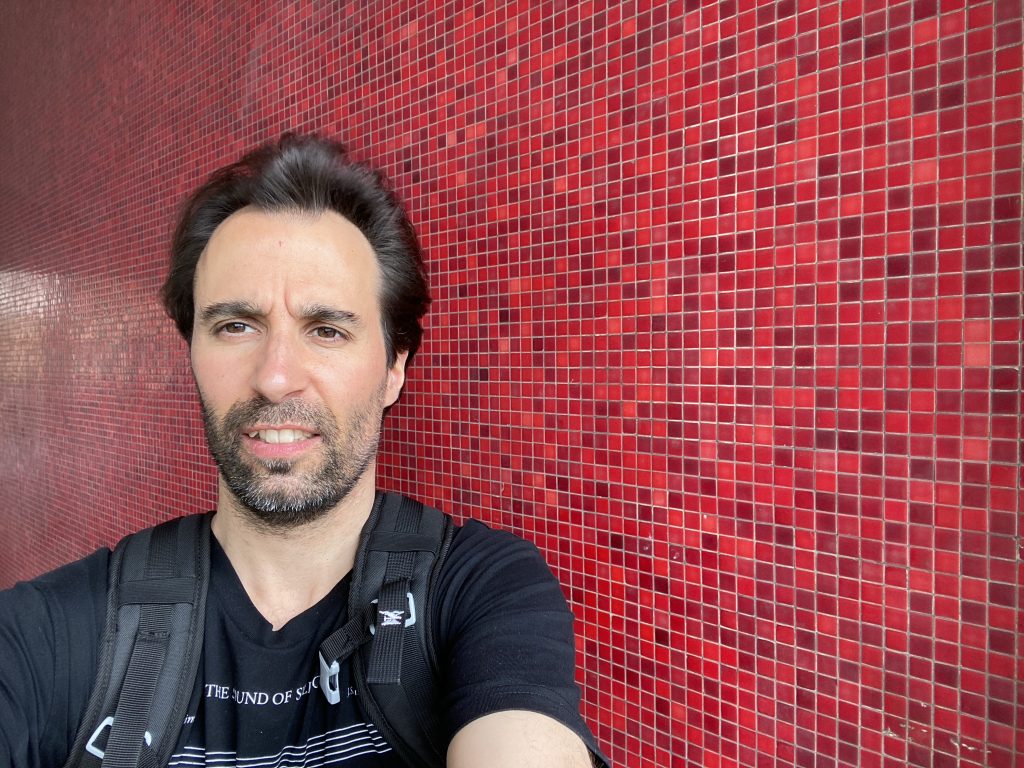
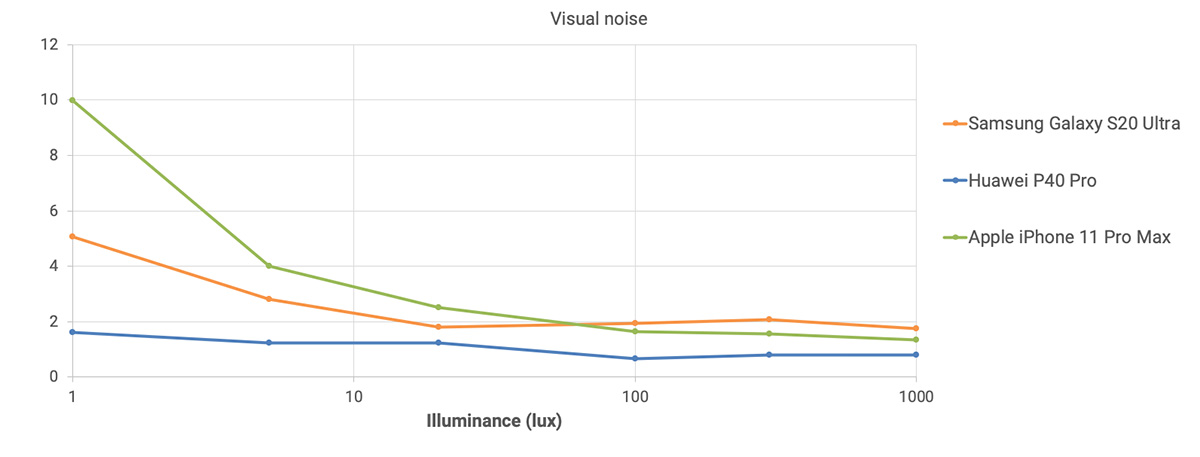



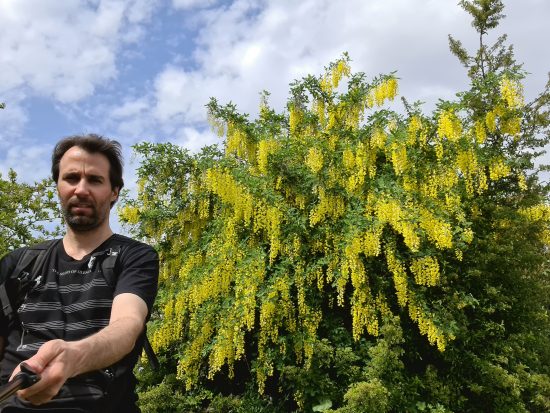












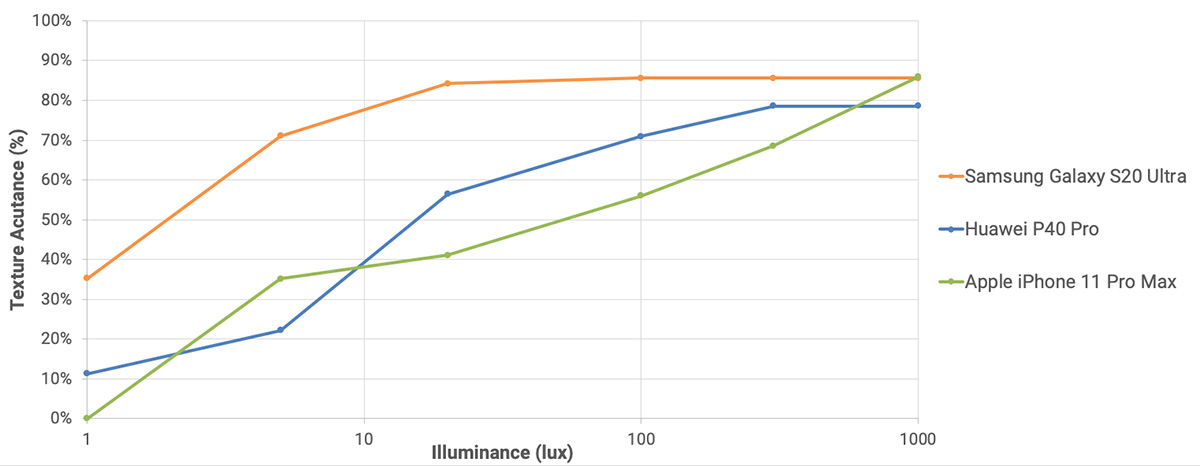
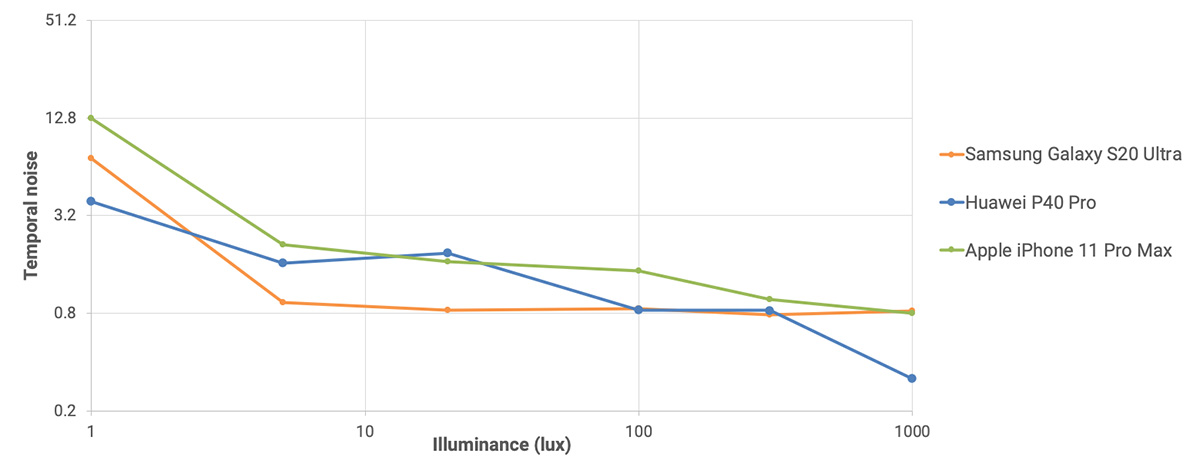
DXOMARK encourages its readers to share comments on the articles. To read or post comments, Disqus cookies are required. Change your Cookies Preferences and read more about our Comment Policy.